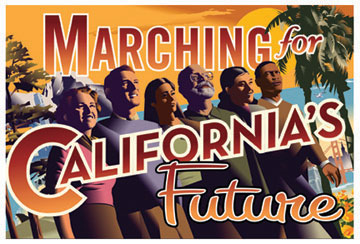Marty Hittelman is the president of the California Federation of Teachers.
 It is no longer enough to say that "Sacramento politics is dysfunctional," or that the political and legislative processes in the Capitol are stymied by "partisan gridlock." These first impressions have some basis in reality but don't adequately address California's real problems. These impressions only lead to a feeling of inevitability, cynicism, and despair.
It is no longer enough to say that "Sacramento politics is dysfunctional," or that the political and legislative processes in the Capitol are stymied by "partisan gridlock." These first impressions have some basis in reality but don't adequately address California's real problems. These impressions only lead to a feeling of inevitability, cynicism, and despair.
What we need in public discussion is a clear picture of the problem and then a plan to fix it. And we all need a sign of hope that change will come. That's why, on March 5, we begin a "March for California's Future." The March will start with a group of public employees who will walk from Bakersfield to Sacramento. By April 21 the March will swell, as it reaches Sacramento, to many thousands. This 250 mile march, sponsored by the California Federation of Teachers and its diverse allies from labor, the faith community, and other civic supporters, is designed to draw attention to the underlying causes of the state's woes as well as gather signatures for a majority budget initiative.
The "March for California's Future" plans to kick start a "reality" discussion on how all Californians can join the fight for a livable California. The three themes of the march are "restore the promise of public education," "a government and economy that works for all," and "fair taxes to fund California's future."
One of the marchers is Irene Gonzalez. She grew up in foster homes throughout the Central Valley. Determined to make something of herself, she worked hard to put herself through school, eventually earning a masters degree. Today she is a probation officer, helping her clients stay out of trouble and on the right track to become productive members of society. In that process she keeps the rest of us safer too. Gonzalez's job would be difficult under any circumstances. But now it's almost impossible. State funding cuts over the last few years have eliminated counseling and educational services for her clients, and the economic recession has narrowed what limited employment options they might have had. "I'm marching," says Gonzalez, "because I want the people I work with to have an opportunity, like I did, to become somebody--so that they don't sink back to where they came from."
Another marcher is Jim Miller. He's a professor of English and Labor Studies at San Diego City College. Due to funding reductions to public education, SDCC offers hundreds of fewer classes than it did a year ago. Lost classes throughout California represent lost opportunities, and coupled with student fee increases, have meant the path to a better job or career through higher education is being blocked. Hundreds of thousands of potential community college students have already been forced from the system. Miller has another reason for marching: "My son is in kindergarten. I know it won't help his education as class sizes rise in the first grade from 23 to 30 kids."
Why is this happening? California was heading in the wrong direction even before the recession, due to two linked problems. First, tax rates for the richest Californians and big business have been reduced over the past fifteen years. In addition, between 1995 and the present, the top one percent of income earners--people who make on average 2.1 million dollars per year--have more than doubled their incomes in real terms. Their lowered state tax rates have cost the state billions of dollars in revenue each year. Most Californians are paying a fair share while the rich and powerful continue to receive more tax loopholes every year. We must reverse this trend and return to the time when wealthy individuals and corporations contributed at a reasonable rate.
Second, although a clear majority of the state Legislature understands the value of public services, their efforts to restore the revenue sources once available to fund education, public health and support services, and build the infrastructure California requires, have been blocked by a unique, undemocratic rule. California is the only state in the country to require a 2/3 supermajority vote to pass both a budget and any state tax increase. Just over one third of the Legislature has signed anti-government activist Grover Norquist's "No new taxes" pledge. Norquist famously remarked that his goal was to cut government to a size it could be "drowned in a bathtub." California is currently moving in that direction.
In the last two years, the California state budget has been reduced by 20%. Our schools have been cut by over $17 billion. Irene Gonzalez, Jim Miller, and the other public employees on the "March for California's Future" have seen first hand the results of this choice. Democracy is no longer in charge of Sacramento; instead, ideology is in control, benefiting the richest and most powerful while dismantling the California Dream for the rest of us.
We don't have to let California go down that drain. March with us to restore the promise of the golden state.
For more about the March for California's Future, go to www.Fight4CAFuture.com.